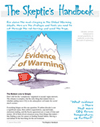|
|
(I’m revisiting older important papers and setting up resource pages, largely thanks to Tony Cox’s prodding. In this post I found it interesting that Lindzen’s work, which was so controversial because it proved the IPCC is wrong, was in many ways merely confirming earlier results. — Jo) Guest Post: Tony Cox and Jo Nova Satellite measurements agree with the ocean heat content measurements. As the Earth warms, more radiation escapes to space.
If feedbacks are positive (as the IPCC estimates), then as the Earth warms the amount of energy being radiated to space will shrink (thus warming the Earth even further). If feedbacks are negative, as the Earth warms more energy will radiate away.
Multiple studies show that feedbacks are negative.
Lindzen and Choi analyzed short periods of warming looking for changes in the outgoing long-wave radiation leaving from the top of the atmosphere. The satellite observations show, repeatedly, that as the Earth warms, the climate system shifts and lets more of the infra red or long-wave energy out to space.[1],[2] It’s like a safety release valve. This means that the system has negative feedbacks (like almost all known long-lived or stable natural systems). The changes dampen the effects of […]
Here’s a forgotten paper that deserves more attention: Idso 1998.
Rather than using an enormously complex global circulation model (or 22) to come up with a figure for climate sensitivity, Sherwood Idso does calculations from eight completely different natural experiments which all arrive at similar figures. In short, he reviewed 20 years of work to arrive at a prediction that if CO2 is doubled we will get 0.4°C of warming at most, and even he admitted, it might be an overestimate. Basically by the time CO2 levels double, he says we ought expect 0 – 0.4°C of warming, after feedbacks are taken into account. Idso started off assuming that the feedbacks were largely positive, but repeatedly found that they were negative.
Idso’s approach was novel. Instead of climate sensitivity to CO2, he estimates the sensitivity of the Earth to any factor. He calls it the “surface air temperature sensitivity factor“. Once something known heats or cools the Earth, how much do the net feedbacks amplify or dampen that initial change? Rather than trying to measure and capture every single feedback and process, and then calculate the end results, Idso finds situations where he can isolate a factor and calculate […]
David Archibald, polymath, makes a bold prediction that temperatures are about to dive sharply (in the decadal sense). He took the forgotten correlation that as solar cycles lengthen and weaken, the world gets cooler. He refined it into a predictive tool, tested it and published in 2007. His paper has been expanded on recently by Prof Solheim in Norway, who predicts a 1.5°C drop in Central Norway over the next ten years.
Our knowledge of they solar dynamo is improving, and David adds the predicted solar activity ’til 2040 to the analysis. Normal solar cycles are 11 years long, but the current one (cycle 24) is shaping up to be 17 years (unusually long), and using historical data from the US, David predicts a 2.1°C decline over Solar Cycle 24 followed by a further 2.8°C over Solar Cycle 25. That adds up to a whopping 4.9°C fall in temperate latitudes over the next 20 years. We can only hope he’s wrong. As David says ” The center of the Corn Belt, now in Iowa, will move south to Kansas.”
He also predicts continuing drought in Africa for another 14 years, with droughts likely in South America too.
If he’s right, […]
There goes another scare campaign.
Until recently we had very little data about real time changes in ocean pH around the world. Finally autonomous sensors placed in a variety of ecosystems “from tropical to polar, open-ocean to coastal, kelp forest to coral reef” give us the information we needed.
It turns out that far from being a stable pH, spots all over the world are constantly changing. One spot in the ocean varied by an astonishing 1.4 pH units regularly. All our human emissions are projected by models to change the world’s oceans by about 0.3 pH units over the next 90 years, and that’s referred to as “catastrophic”, yet we now know that fish and some calcifying critters adapt naturally to changes far larger than that every year, sometimes in just a month, and in extreme cases, in just a day.
Data was collected by 15 individual SeaFET sensors in seven types of marine habitats. Four sites were fairly stable (1, which includes the open ocean, and also sites 2,3,4) but most of the rest were highly variable (esp site 15 near Italy and 14 near Mexico) . On a monthly scale the pH varies by 0.024 to 1.430 […]
A blockbuster Chinese study of Tibetan tree rings by Liu et al 2011 shows, with detail, that the modern era is a dog-standard normal climate when compared to the last 2,500 years. The temperature, the rate of change — it’s all been seen before. Nothing about the current period is “abnormal”, indeed the current warming period in Tibet can be produced through calculation of cycles. Liu et al do a Fourier analysis on the underlying cycles and do brave predictions as well.
In Tibet, it was about the same temperature on at least four occasions — back in late Roman times (those chariots!), then again in the dark ages (blame the collapse of industry), then in the middle ages (the Vikings?), then in modern times (blame the rise of industry).
Clearly, these climate cycles have nothing to with human civilization. Their team finds natural cycles of many different lengths are at work: 2-3 years, 100 years, 199 years, 800 years, and 1,324 years. The cold periods are associated with sunspot cycles. What we are not used to seeing are brave scientists willing to publish exact predictions of future temperatures for 100 years that include rises and falls. Apparently, it will […]
The ocean acidification threat is a big can of worms. I asked Professor Brice Bosnich to help create a quick reference page on the chemistry and was pleased he could find the time to help. Here’s everything you wanted to know about the basics…
He explains what pH means, and points out that:
Ocean pH varies by 0.3 naturally. Claims of acidification since 1750 are based on dubious models and few observations.
There are reasons to assume that marine life will not be overly affected by an increase in ocean acidity due to atmospheric carbon dioxide:
Ocean life evolved and survived far higher levels of CO2 for millions of years in the past. Marine organisms actively create carbonate shells (using energy) which means crustacea, corals and molluscs aren’t automatically prey to pH changes in the same way that say a limestone rock would be. The world’s oceans may have warmed a mere 0.17C since 1955, hardly a significant threat to marine life.
We also find out that acidic water is added to the ocean from rainfall and floods (and he explains why raindrops will always be acidic).
There are more pressing threats. — Jo
———————————————————–
Guest Post by Professor […]
Dr David Evans lays out four crucial pieces of evidence, and calls for a debate with Prof Andrew Pitman. But the evidence is so unarguably strong for skeptics, we know that the name-calling-team-who-want-our-money will do anything to avoid a public debate. If the evidence is “overwhelming” why are they so unwilling to explain it? — Jo
—————–
Submission to the Inquiry into Carbon Tax Pricing Mechanisms
Dr David Evans
20 September 2011
Dr David Evans consulted full-time for the Australian Greenhouse Office from 1999 to 2005, and part-time to the Department of Climate Change from 2008 to 2010, modeling Australia’s carbon in plants, debris, mulch, soils, and forestry and agricultural products. Evans is a mathematician and engineer, with six university degrees including a PhD from Stanford University.
Global warming has become a scam. Let me explain how it works.
It has superficial plausibility. Yes, global warming is occurring. Yes, carbon dioxide is a greenhouse gas and levels are rising. And yes, every molecule of carbon dioxide we emit causes some global warming.
Many non-scientists think that proves the case, but it doesn’t. In particular, it doesn’t rule out the possibility that carbon dioxide is merely […]
TODAY June 7th 2011: Phenomenal eruption on the sun (see the bottom of the post for more info).
Apparently previous studies of the sun-climate connection looked at the equatorial polar magnetic field which produces sun spots, but they did not consider the polar magnetic component of the solar dynamo. The polar fields are less strong than the equatorial fields, but it is claimed that the total magnetic fluxes of both fields are comparable. With proxy data they derive an empirical relation between tropospherical temperatures and solar equatorial and polar magnetic fields. The polar field could contribute about 30% as much as the equatorial field.
The paper, published in the Journal of Atmospheric and Solar-Terrestrial Physics focused on the period 1844-1960 (but extended at least one graph back to 1600) and finds our current warming period is not that different from earlier episodes and that the increase in solar activity in the last 400 years explains the warming, without any need to invoke a man-made enhanced greenhouse hypothesis.
7.8 out of 10 based on 4 ratings […]
It appears the warming of the 20th Century has been done before. It’s just business as usual for the planet.
Frank Lansner has been hard at work again, and we’ve been discussing the Vostok ice cores. This time Lansner was looking to see if the current warming trend was unusual, and if there was evidence to support the high climate sensitivities the models suggest. As it happens, most of those high climate sensitivities that the models “estimate” come not from carbon dioxide directly, but from the feedbacks (the way the planet responds to any small change in temperature).
The models assume the net feedbacks are positive. These same feedbacks ought to have been working 100,000 years ago, and if so, there should be some hint of it in the ice cores. Lansner has been hunting for large swings in temperature during the periods when Earth was at a similar temperature to present day conditions — but what he finds is that the current claimed rise of 0.7 degrees C over the last century, even if it were true (and not exaggerated by thermometer siting, the UHI, inexplicable adjustments, or selective use of records) […]
What do you know? The Medieval Warm Period, which either “didn’t exist” or “only happened in Europe”, also hit Western Antarctica.
Booth Island and Mount Scott are also on the Antarctic Peninsula. Photo: Stan Shebs.
The climate models don’t know why the world was warmer 1000 years ago. They don’t know why it cooled into the Little Ice Age either. The models don’t do regional projections well, and they don’t do seasonal projections with any skill, and they (in the last ten years) don’t work on short decadal timeframes either, but surely when it comes to big global temperature changes the models have got all the major forces figured out? Surely they’d be able to predict large movements across the entire globe eh? — but the first test we come to, a mere thousand years ago, shows the models have a predictive ability not significantly different from a coin toss.
Just because it was warmer 1000 years ago (due to some other reason), doesn’t mean that CO2 isn’t responsible for this warming cycle, but when all the evidence for CO2’s guilt comes only from models that can’t get the last warming cycle right, and from argument from ignorance (“Our […]
How bad are these datasets? How sloppy are the data records?
Western Australia (WA) covers 2.5 million square kilometers (1 million square miles, about a third as big as the USA). The average of all WA stations over one month last year was adjusted up by as much as a gobsmacking 0.5 degrees due to a database “bug” – which contributed to August 2009 being the hottest August on record?! That’s one heck of a bug!
Could it get worse? Unbelievably, GISS seems to have lost data for key WA locations that an unpaid volunteer found easily in the BoM online records. GISS only has to maintain copies of records for sixteen stations in WA* which have temperatures current to 2010, but in seven of them they are missing data, and it affects the results. Are they random errors? No, shock me, six errors are upwards: in one case making the spring 2009 average temperatures for Kalgoorlie-Boulder 1.1 C degrees warmer!
But with no-one auditing our BoM or NASA’s GISS, and no team jointly receiving raw data or regulating standards in either agency, temperatures recorded in the field could potentially be listed in official records as being quite […]
This point is THE critical one. It was the first point raised in the Skeptics Handbook, developed in the Second Handbook; the point that Dr Glikson had no reply to; the point that tripped up Will Steffen, Deltoid, and John Cook. As a modeler there was the moment in August 2007 when David saw the graphs below and said, emphatically: This is it. It’s over for the climate models. –JN
The public might not understand the science, but they do understand cheating
Dr. David Evans 19 October 2010
[A series of articles reviewing the western climate establishment and the media. The first and second discussed air temperatures, the third was on ocean temperatures, and fourth discussed past temperatures, the fifth compared the alleged cause (human CO2 emissions) with the alleged effect (temperatures), the sixth canvassed the infamous attempt to “fix” that disconnect, the hockey stick, and the seventh pointed out that the Chinese, Russian, and Indian climate establishments […]
The public might not understand the science, but they do understand cheating
Dr. David Evans
6 October 2010
[A series of articles reviewing the western climate establishment and the media. The first and second discussed air temperatures, the third discussed ocean temperatures, and the fourth discussed past temperatures.]
Click to download a pdf file containing the whole series
Notice How They Never Directly Compare Temperature With Human Emissions of CO2?
According to the man-made theory of global warming promoted by the western climate establishment, the recent global warming is due to human emissions of greenhouse gases, which are dominated by carbon dioxide (CO2).
So let’s compare the alleged cause (human emissions of CO2) with the alleged effect (temperature).
Human emissions of CO2 have been estimated from historical data for the period 1751 (before the industrial revolution) to 2007 for the major sources—coal, gas, and petroleum use, cement production, and gas flaring—by the Carbon Dioxide Information Analysis Center within the US Department of Energy. (The cumulative figures below extrapolate to 2010 using average annual emissions for the previous 14 years.)
8.2 out of 10 based on 16 ratings […]
UPDATED (below)
Think of this as a car crash. NIWA says: “The car’s fine, there’s nothing wrong with it.”
Then: “We can’t find the keys (actually we’ve lost the car)”.
Later: “We weren’t driving it”.
Finally: “The car doesn’t exist”.
There’s a litany of excuses. The National Institute for Water and Atmospheric Research (NIWA) claims New Zealand has been warming at 0.92°C per 100 years. But when some independent minded chaps in New Zealand graphed the raw NZ data, they found that the thermometers show NZ has only warmed by a statistically non-significant 0.06°C. They asked for answers and got nowhere, until they managed to get the light of legal pressure onto NIWA to force it to reply honestly. Reading between the lines, it’s obvious NIWA can’t explain or defend the adjustments.
Richard Treadgold was one of that team and wrote it up here.
The legal documents:
August 2010: The NZ Climate Science Coalition’s put together legal claims.
The NZCSC filed judicial review proceedings against NIWA, requesting the Court to:
• Declare the 7SS invalid • Direct NIWA to prepare […]
…
The establishment barks “cherry-picking” at skeptics who claim a particular year was cold, or quiet, or less stormy, but where are the caveats when the mass media churns out record single “hot year” headlines as if they matter: 2010 is hottest year EVER!
What’s not obvious is that breaking those records depends on the data set. According to satellite data there have been no “hottest year ever” records since 1998, though as it happens, NASA doesn’t seem too keen on using data recorded from space. Go figure.
With ground stations, every single station requires hand-made “adjustments” and many stations are ignored completely. The results from ground stations are “interpreted” to cover anything from zero kilometers right up to 1200 km. I guess, only a God of Science would know which thermometer has that magic-1200-gift. Meanwhile, the satellite records are a massive collection of data recorded continuously 24/7, year after year and covering all round the globe, land and sea.
Part II of this series is about those “adjustments” and the different data sets.
— JN
Part 2: Air Temperatures
The public might not understand the science, but […]
Ken Stewart has been hard at work again, this time analyzing the Australian urban records. While he expected that the cities and towns would show a larger rise than records in the country due to the Urban Heat Island Effect, what he found was that the raw records showed only a 0.4 degree rise, less than the rural records which went from a raw 0.6 to an adjusted 0.85 (a rise of 40%). What shocked him about the urban records were the adjustments… making the trend a full 70% warmer.
The largest adjustments to the raw records are cooling ones in the middle of last century. So 50 years after the measurements were recorded, officials realized they were artificially too high? Hopefully someone who knows can explain why so many thermometers were overestimating temperatures in the first half of the 1900’s.
50 years later?
The raw Australian urban temperature records are in blue. The adjusted records in red. Note that temperatures in the middle of last century appear to be adjusted downwards. These are the annual average recordings for all 34 sites.
Remember Dr David Jones, Head of Climate Monitoring […]
The ice cores are often lauded as evidence of the effects of carbon dioxide. Frank Lansner asks a pointed question and goes hunting to find any effects that can be attributed to carbon.
Where is the data that actually shows a strong and important warming effect of CO2? If CO2 has this strong warming effect, would not nature reflect this in data?
He has collected together the data from the last four warm spells (the nice interglacials between all the long ice ages) into one average “peak”. The common pattern of the rise and fall has already been recorded in many scientific papers. Orbital changes trigger the temperatures to rise first and about 800 years later (thanks to the oceans releasing CO2), carbon dioxide levels begin to climb. At the end of a patch of several thousand warm years, temperatures begin to fall, and thousands of years later the carbon dioxide levels slowly decline. No one is really contesting this order of things any more. What is contested is that those who feel carbon is a major driver estimate that the carbon dioxide unleashed by the warming then causes major amplification or […]
Are the small islands of the South Pacific in danger of disappearing, glug, under the waves of the rising ocean? Will thousands of poor inhabitants be forced to emigrate, as desperate refugees, to Australia and New Zealand? Has any of this got anything to do with man-made emissions of CO2?
By looking closely at the records, it turns out that the much advertised rising sea levels in the South Pacific depend on anomalous depressions of the ocean during 1997 and 1998 thanks to an El Nino and two tropical cyclones. The Science and Public Policy Institute has released a report by Vincent Gray which compares 12 Pacific Island records and shows that in many cases it’s these anomalies that set the trends… and if the anomaly is removed, sea levels appear to be more or less constant since the Seaframe measurements began around 1993.
Sea levels: The El Nino / tropical storm anomaly in 1997-1998 is clear. A long sustained rise is not.
Take the infamous Tuvalu for example. It’s sea level rise was reported as 5.7 mm/year back in 2008. Now it’s calculated as 3.7mm/year. But look at the Seaframe Graph – its flat. It is universally forecast […]
Round 5 of my debate with Andrew Glikson Dr Andrew Glikson and I have been debating the evidence first through Quadrant, and then here. Kudos to him for following this up in a polite, diligent manner. This kind of open debate is extremely rare, and I am happy to encourage it. I will post a reply in a few days. For the moment I think the many able commenters here can discuss its merits. The only thing I’ll say now is that in each of my four previous replies I ask for evidence that the models are right on the magnitude of the feedbacks. Is it half a degree or 3.5oC? Part I: AG / JN; Part II: AG / JN; Part III: AG / Part III & IV: JN (& AG). (Part IV took place in the comments below Part III). Yes, this is the first time I’ve had a guest post from a scientist who disagrees… My reply is here. — Jo
Guest Post by Andrew Glikson
Earth and Paleoclimate scientist Australian National University, 18 May, 2010
Dr Andrew Glikson ANU
Unique among the terrestrial planets, occupying an intermediate position between Venus, with […]
Dr Andrew Glikson (an Earth and paleoclimate scientist, at the Australian National University) contacted Quadrant offering to write about the evidence for man-made global warming. Quadrant approached me asking for my response. Dr Glikson replied to my reply, and I replied again to him (copied below). No money exchanged hands, but Dr Glikson is, I presume, writing in an employed capacity, while I write pro bono. Why is it that the unpaid self taught commentator needs to point out the evidence he doesn’t seem to be aware of? Why does a PhD need to be reminded of basic scientific principles (like, don’t argue from authority). Such is the vacuum of funding for other theories that a debate that ought to happen inside the university obviously hasn’t occurred. Such is the decrepit, anaemic state of university science that even a doctorate doesn’t guarantee a scientist can reason. Where is the rigor in the training, and the discipline in the analysis?
Credibility lies on evidence
by Joanne Nova
April 29, 2010
Reply to Andrew Glikson
Dr Andrew Glikson still misses the point, and backs his arguments with weak evidence and logical errors. Instead of empirical evidence, often […]
|
JoNova A science presenter, writer, speaker & former TV host; author of The Skeptic's Handbook (over 200,000 copies distributed & available in 15 languages).

Jo appreciates your support to help her keep doing what she does. This blog is funded by donations. Thanks!


 Follow Jo's Tweets
Follow Jo's Tweets To report "lost" comments or defamatory and offensive remarks, email the moderators at: support.jonova AT proton.me
Statistics
The nerds have the numbers on precious metals investments on the ASX
|












Recent Comments